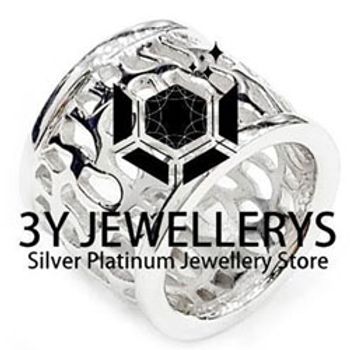The Difference Between Jade and Jadeite
Jade stone itself is a gemstone from natural. In Chinese words, “the finest of stone is Jade”. The qualities of jade stone are hard and fine, and with uniform hue and color, and beautiful crystal-like shine. Jade refers collectively to two different minerals --- Jadeite and Nephrite. Most Jade of gem value is Jadeite Burmese Jade. Most valuable is the Imperial Jade, an emerald green transparent jadeite from Burma. Jadeite is generally very expensive, while nephrite is still quite affordable.
Jadeite is one of the jade stone’s forms. However, a jade stone does not necessary is a Jadeite.
In Chinese, Jadeite is called “Fei Cui”. There has wide range of variations in color of Jadeite. The color is mostly found in white, green, red, purple, blue, yellow, black and pink.
Jadeite and Nephrite have different characteristics:
| Nephrite | Jadeite | |
| Hardness | 6.0 ~ 6.5 | 6.5 ~ 7.0 |
| Specific gravity | 3.0 | 3.33 |
| Refractive index | 1.62 | 1.66 |
| Polished surfaces | Smooth with a waxy sheen | Hard and lustrous |
| Colour | Evenly distributed; translucent white, dark green, black | Spotty or clustered distribution; white, grey, green |
Type “A” – Natural Jadeite
Refers to natural jadeite which is not subject to any form of chemical treatment except those traditional processes as plum juice washing and was polishing. These procedures are internationally recognized as standard practice and are not defined as “treatment” because the structure of jadeite has not been damaged.
Type “B” – Chemically Bleached and Polymer impregnated Jadeite
Refers to stones which have been chemically bleached to remove impurities, It is further rinsed with caustic soda and followed by impregnation of polymer to enhance translucency. The structure of jadeite damaged through this treatment and will lose its luster once the polymer deteriorates in several years. In additional, type “B” goods cannot withstand heat and pressure.
Type “C” – Dye Coloured Jadeite
Jadeite of this kind are usually colourless or very faint tone, which are therefore dyed to enhance its brightness. However, such artificial hue will gradually fade out with the lapse of time.
翡翠和玉的区别
很多人不了解"翡翠"和"玉"的概念,错误地把"玉"理解为"翡翠"。其实翡翠和玉石有区别的。广泛的讲,玉包括:翡翠,和田玉,岫玉,蓝田玉,独山玉,黄玉,八三玉,马来玉,东陵玉等等。还有你您所听过的各种玉,它们都叫玉,同时也包含天然的和人工的。
“翡翠确实是玉,但反过来说,玉就不一定是翡翠”
什么是翡翠
一般说的硬玉就是翡翠。翡翠是玉石之王,是唯一国际认可的宝石级的玉石,她具有其他众多玉石品种不可比拟的特点与优势。具体说来,翡翠具有六大显著特点:颜色丰富、物性稳定、光泽强、折射率高、比重大、硬度高,另外,宝石级翡翠仅产于缅甸特定的矿脉中,产地的唯一性也注定了她高贵的品质——"物以稀为贵"。
什么是玉
软玉就是硬度低于翡翠的天然玉石。最具代表性的是和田玉,一种产自新疆的优质软玉,其美丽的外观、细腻温润的手感和它不菲的投资收藏价值,是中国玉中的佼佼者。另外,岫玉、独山玉、青田玉、鸡血玉、寿山玉、青海翠、贡玉、绿松石等也都称为玉,但其中一部分称为“石”更恰当。
翡翠与软玉的区别
软玉的硬度为6.0-6.5,翡翠(即硬玉)硬度是6.5-7.0,两者结构相同,均为纤维交织结构,是最致密,最稳定的结构。
根据其颜色,软玉可划分为:白玉、青玉、碧玉、墨玉、黄玉、糖玉等几种重要品种。软玉与翡翠的比较明显的区别有:
两者间的结晶颗粒形状有着本质上区别
软玉的矿物结晶颗粒为白糖状的颗粒结构,而翡翠则是柱状或纤维状的结晶颗粒结构,翡翠具有特有的"翠性",而软玉没有这一特性,因此从反光面或透着光就能判断翡翠还是软玉;
光泽是翡翠越软玉的最大性质区别之一
光泽是翡翠越软玉的最大性质区别之一。稍微有点经验的人都能通过反射光来判断软玉和翡翠,软玉表面呈现的是强弱不一致的油脂光泽,这样的光泽是柔和、温暖的,因此人们理解为温性的玉石。而翡翠的反射光泽呈现的刚硬的玻璃光泽,光泽中透露着冰凉的寒意,因此称为寒心玉石;
比重 : 软玉的比重(3.00)略比翡翠(3.33)的比重低
折射率 : 软玉的折射率(1.62)亦略比翡翠(1.66)的折射率低
A 玉 (天然硬玉)
没有经过化学处理的天然翡翠,祗经过传统制作过程:以炭灰水和酸梅清洁翡翠在制作和打磨时留下的污渍,再以无色四川白蜡润泽翡翠表层。这工序符合国际珠宝界标准,没有加入外来物质而破坏翡翠的结构。
B 玉 (经化学处理及注入高聚脂硬玉)
翡翠经过化学处理后,其结构已遭破坏。因为在处理过程中,以硝酸清除翡翠内的杂质,再以荷性纳清洁酸液,然后注入高聚脂(树脂、胶质),使玉质变得更晶莹通透。日后当高聚脂变质时,翡翠的质地也随之变得疏松和失去光泽。此外,这种玉器不能承受天然翡翠可承受之热力和压力。
C 玉 (染色处理硬玉)
玉体本没有颜色或有很淡的颜色,经染色后,玉体的颜色变得鲜艳。但日久其颜色会渐渐淡褪。
